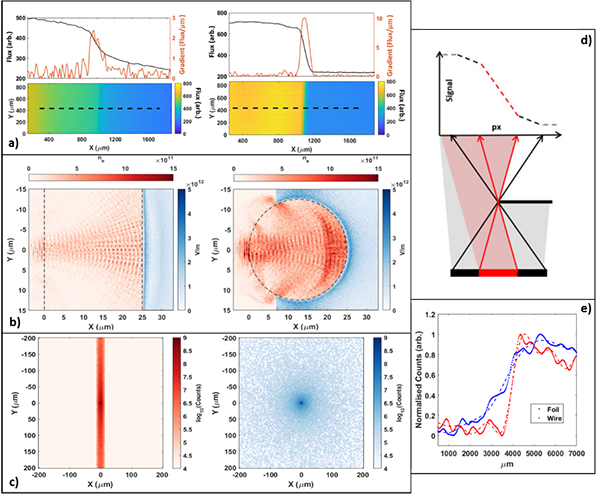Due to the range of size, density, and resolution demands associated with industrial x-ray radiography, there is not a source that is “one-size fits all”. Compromises and optimisations must be made depending on the object of study. For example, the X-ray source required to image a small biological sample is significantly different in both spectral and spatial demands to that for an aircraft weld. Both examples, however, are readily achieved with laser driven systems. Altering the source characteristics to deliver what is needed requires continued study. This publication explores the X-ray emission from spatially constrained targets compared to standard foil targets. The research results are published in High Power Laser Science and Engineering, Volume 7, No. 2, 2019 (Armstrong, C. D. , et al. Bremsstrahlung emission from high power laser interactions with constrained targets for industrial radiography).
The data within this publication was measured during an experimental campaign using the Vulcan laser in Target Area West. We worked in conjunction with industrial partners to characterise and optimise the X-ray emission from solid target interactions with high intensity lasers. Changing the target from a foil configuration to a wire configuration was expected to improve the spatial profile of the X-ray source since there is a confined volume from which X-rays can be generated. The flux of X-ray sources is also investigated, a comparison between 25-100 μm wires and 25-600 μm thick foil is shown.
In thick targets, electrons are more likely to collide with the target material and emit bremsstrahlung prior to interacting with the sheath on the rear surface. When interacting with the sheath, electrons typically lose some energy and subsequently recirculate through the target. This recirculation causes an increase in the spatial extent of the source, as the electrons continue to travel laterally through the target. These recirculating electrons still have significant energy enough to readily generate X-rays as they continue to circulate the target.
Switching to a wire target geometry removes the flux produced from the substrate, in the transverse direction, as there is no material from which to generate X-rays. Experimentally, we show that changing from a foil target to a wire target constricts the electron expansion as the electric field on the rear-surface of the target builds rapidly and covers a high proportion of the available surface area. The change in the sheath field results in a higher population of cooler recirculating electrons, which in turn results in an increase in the measured X-ray flux. Simulations using EPOCH in 2D show the sheath field developing faster on the wire target geometry, and by using the recirculating population outputted from EPOCH in a GEANT4 simulation, the increase in x-ray emission is demonstrated by applying electric fields to the target surfaces.
This simple targetry change is readily applicable to X-ray generation with solid targets, demonstrating a significant improvement in both the spatial resolution and the overall flux of the source, without necessitating invasive or complex experimental set ups. Going forward this technique can be applied to improve the image quality without necessitating a higher energy laser driver, the simulations demonstrate a 3x improvement in the conversion efficiency from electrons to X-rays and the experimental data shows a 1.5-2x increase in the detected X-ray flux and a 2.6x increase in the spatial resolution for an industrial sample.


Comparison of wire and foil targets, a) spatial profile of X-ray emission area, b) electron density (red) and field generation (blue), c) X-ray source location from GEANT4 simulations, d) Schematic of multiple X-ray source characterisation, e) ESF from sample object for each target type.


